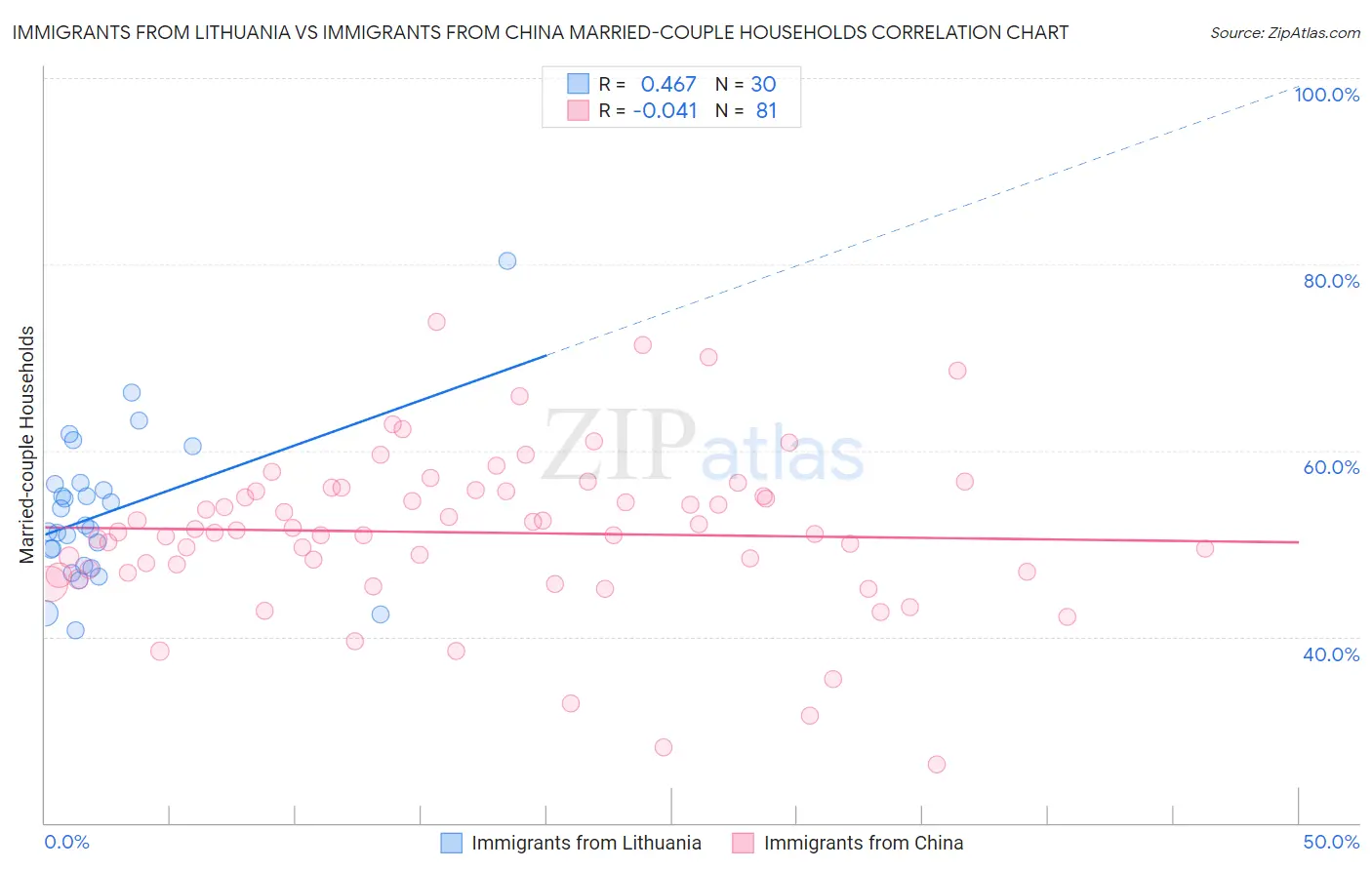Immigrants from Lithuania vs Immigrants from China Married-couple Households
COMPARE
Immigrants from Lithuania
Immigrants from China
Married-couple Households
Married-couple Households Comparison
Immigrants from Lithuania
Immigrants from China
48.6%
MARRIED-COUPLE HOUSEHOLDS
99.3/ 100
METRIC RATING
54th/ 347
METRIC RANK
48.4%
MARRIED-COUPLE HOUSEHOLDS
98.9/ 100
METRIC RATING
69th/ 347
METRIC RANK
Immigrants from Lithuania vs Immigrants from China Married-couple Households Correlation Chart
The statistical analysis conducted on geographies consisting of 117,713,976 people shows a moderate positive correlation between the proportion of Immigrants from Lithuania and percentage of married-couple family households in the United States with a correlation coefficient (R) of 0.467 and weighted average of 48.6%. Similarly, the statistical analysis conducted on geographies consisting of 456,566,781 people shows no correlation between the proportion of Immigrants from China and percentage of married-couple family households in the United States with a correlation coefficient (R) of -0.041 and weighted average of 48.4%, a difference of 0.37%.

Married-couple Households Correlation Summary
| Measurement | Immigrants from Lithuania | Immigrants from China |
| Minimum | 40.7% | 26.3% |
| Maximum | 80.4% | 73.8% |
| Range | 39.7% | 47.4% |
| Mean | 53.3% | 51.2% |
| Median | 51.7% | 51.3% |
| Interquartile 25% (IQ1) | 47.6% | 46.9% |
| Interquartile 75% (IQ3) | 56.4% | 55.7% |
| Interquartile Range (IQR) | 8.7% | 8.8% |
| Standard Deviation (Sample) | 8.1% | 8.7% |
| Standard Deviation (Population) | 7.9% | 8.6% |
Demographics Similar to Immigrants from Lithuania and Immigrants from China by Married-couple Households
In terms of married-couple households, the demographic groups most similar to Immigrants from Lithuania are White/Caucasian (48.6%, a difference of 0.010%), Austrian (48.6%, a difference of 0.010%), Immigrants from Northern Europe (48.6%, a difference of 0.010%), Irish (48.6%, a difference of 0.060%), and Eastern European (48.6%, a difference of 0.090%). Similarly, the demographic groups most similar to Immigrants from China are Immigrants from South Eastern Asia (48.4%, a difference of 0.0%), Romanian (48.4%, a difference of 0.010%), Jordanian (48.4%, a difference of 0.020%), Immigrants from Canada (48.4%, a difference of 0.040%), and Immigrants from North America (48.4%, a difference of 0.040%).
| Demographics | Rating | Rank | Married-couple Households |
| Eastern Europeans | 99.3 /100 | #51 | Exceptional 48.6% |
| Irish | 99.3 /100 | #52 | Exceptional 48.6% |
| Whites/Caucasians | 99.3 /100 | #53 | Exceptional 48.6% |
| Immigrants | Lithuania | 99.3 /100 | #54 | Exceptional 48.6% |
| Austrians | 99.3 /100 | #55 | Exceptional 48.6% |
| Immigrants | Northern Europe | 99.3 /100 | #56 | Exceptional 48.6% |
| Poles | 99.2 /100 | #57 | Exceptional 48.5% |
| Immigrants | Indonesia | 99.2 /100 | #58 | Exceptional 48.5% |
| Czechoslovakians | 99.2 /100 | #59 | Exceptional 48.5% |
| Croatians | 99.1 /100 | #60 | Exceptional 48.5% |
| Bulgarians | 99.1 /100 | #61 | Exceptional 48.5% |
| Luxembourgers | 99.1 /100 | #62 | Exceptional 48.5% |
| Basques | 99.0 /100 | #63 | Exceptional 48.4% |
| Northern Europeans | 99.0 /100 | #64 | Exceptional 48.4% |
| Immigrants | Canada | 99.0 /100 | #65 | Exceptional 48.4% |
| Jordanians | 98.9 /100 | #66 | Exceptional 48.4% |
| Romanians | 98.9 /100 | #67 | Exceptional 48.4% |
| Immigrants | South Eastern Asia | 98.9 /100 | #68 | Exceptional 48.4% |
| Immigrants | China | 98.9 /100 | #69 | Exceptional 48.4% |
| Immigrants | North America | 98.9 /100 | #70 | Exceptional 48.4% |
| Laotians | 98.8 /100 | #71 | Exceptional 48.4% |